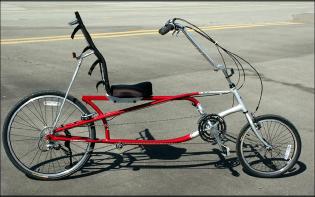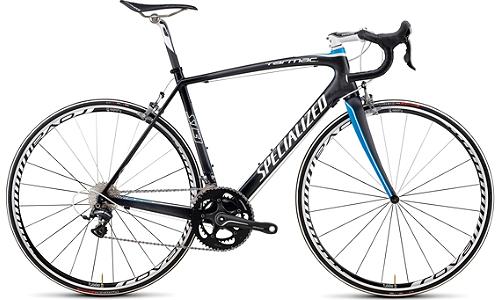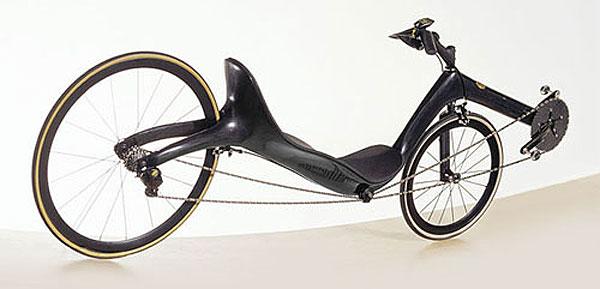
Contact: John Foltz
![]()

![]()
This page attempts to cut through the hype and compare the features and capabilities of two styles of bicycle: the standard Safety Bicycle, a.k.a. Upright, versus the Recumbent. In this context, only pavement concerns are reviewed. For price ranges, I tried to go by what I would consider 'enthusiast level' bikes. Bear in mind that many of these statements are generalizations, and as such are not completely accurate for all examples within a style.
As with any comparison, personal opinions may unavoidably color the results. These are based on my experience: 10 years riding an upright by myself, plus 12 years riding an upright in a club, followed by 5 years riding a recumbent. Until recently, I continued to use an upright for daily commuting, year around. As always, YMMV. The pictures below represent examples of sub-$1000 and over-$2000 bikes of each type. While the biggest differences between the two uprights will be frame material and component level, you can see the recumbents are wildly divergent by comparison.
At the bottom is a summary, in the "Buy If..." motif popularized in
Bicycling Magazine.
|
|
|
|
 Trek 1000 |
 EasyRacers EZ Sport |
 Specialized Tarmac SL3 Pro |
 M5 Carbon Lowracer |
|
|
|
|
| Frame Technology
|
Chromoly and aluminum most common frame material, and both are available in the same price range. Widespread use of butted and aero tubing. Carbon forks are widely available, either OEM or as affordable options. | Chromoly and aluminum most common frame
material, with a premium usually placed upon aluminum.Carbon and titanium
offerings are extremely limited. Butted and aero tubing is uncommon.
|
| Frame Sizing
|
Basically one frame style, can be sized for anyone from children to very tall adults. | Not all styles are suitable for all
heights.
|
| Price Range | $550-$5000+ At the low end, an upright will undisputably give you more performance bang for the buck. |
$800 - $5000+ Low-end recumbents are typically built for comfort and ease of learning, not speed. |
| Comfort
|
Rider is advised to change positions often to avoid sore spots. Rider will usually wear padded gloves and shorts. Typical complaints (when complaints exist:) ‘saddlesore’ i.e. bruised perch bone area, carpal tunnel problems i.e. sore palms and numb fingers, also sore wrists, elbows, shoulders, and neck, tender knees. | Rated by owners as "superior." Complaints
of discomfort of any sort are the exception, not the rule*. Padded
clothing is unnecessary. Typical complaints (when complaints exist:) numb
toes, hot feet, ‘recumbutt’ i.e. sore gluteus muscles, tender knees. Extra
note: carrying items in rear jersey pockets can be uncomfortable, as rider
must sit against them.
*after initial setup |
| Transport
|
Ranges from easy to moderate.
Non-traditional frames cause the most problems, but can be carried via
fork-mount carriers. Relatively easy to hand-carry.
|
Ranges from easy to difficult, depending on model. Some models can be hung on two-arm carriers, some require fork mounts. Cartopping on freeways may require removal of seat. If you use a tray-type carrier, long wheelbase bikes require tandem carrying trays. Most are longer than an upright bicycle. Harder to hand-carry, on average. |
| Storing
|
Typical length: 63 inches For packing, turning the handlebars results in a very narrow package. |
Typical short wheelbase length: 69"
Typical Long Wheelbase Length: 82" Wider seat impairs ability to stack tightly together. |
| Maneuverability (Low Speed)
|
Relatively easy to balance at speeds below 2 mph. Some models allow toe to strike front wheel. Easier to 'thread' in tight spaces. | Balance becomes difficult at speeds below about 3 mph. Some short wheelbase models allow heel to strike front wheel. |
| Maneuverability (High Speed)
|
Has a light ‘feel.’ Rider is disconnected from bike, can throw bike under his/her weight. Weight distribution is variable with body position. In a turn, the outside (low) pedal represents a low pivot point for side to side weight shifts, resulting in faster initiation of small course changes. Cannot pedal in hard cornering. | Rider ‘is one’ with the bike. Center of gravity is low for good cornering, but cannot be easily modified front/back while riding. For side to side weight shifts, the seat represents a higher pivot point than an upright's pedals; so small course changes are slower to initiate. Can pedal in hard cornering, especially high crank models. |
| Technical riding/stunts
|
Capable of various stunts such as
bunnyhopping, jumping up curbs, wheelies, and trackstands. Can be ridden
no-hands, although geometry may sometimes make this tricky.
|
For the most part, stunts are not possible, or when possible are extremely limited. Often use wider tires due to inability to hop over unavoidable obstacles. Regardless of suspension, 'getting air' is not recommended due to the possibility of spinal compression injuries. Most models cannot be ridden no-hands. |
| Weight
|
A good road bike may range from 16 to 22 pounds. Even with optional aerobars, an upright will weigh less than a recumbent. | A good recumbent will weigh between 20 and
30 pounds. (Extra chain length, more elaborate seat, no butted tubing.)
|
| Performance - Uphill Speed (same as sprint
acceleration)
|
Very good. Light weight and ability to
stand are considered main reasons. As mentioned to the right, uprights
lose speed more quickly at the bottom of a hill, but their higher final
climbing speed usually still gives them the edge.
|
Slightly to significantly slower, depending on the hill in question and, of course, the motor. Recumbents typically lose speed less quickly on an uphill, so very short climbs may actually be faster. Most have lower low gears due to inability of the rider to stand while pedaling, as well as to accomodate slower final climbing speeds. |
| Performance -Downhill Speed | Average to very good. Can obtain aero profile on drops or by using aero bars. | Average to excellent. Performance riders are advised to power down hills to take advantage of higher terminal velocities, especially when another climb is imminent. |
| Performance - Flats Speed
|
See above. With the rider on the hoods or top of the handlebar, performance is compromised in favor of comfort. Using drops or aerobars and paying attention to body position will result in much better speeds, but may require extensive training to achieve and maintain. | Some recumbents with very upright seat backs may not have any performance advantage. Most sport-oriented recumbents have speed capabilities similar to riding an upright on the drops, while lowracers and highracers allow dramatically higher speeds. |
| Performance - Pacelines
|
Work very well due to short length, upper body positioning, and ability to follow each other closely. Front wheel is vulnerable, but this is not usually a problem since it is readily visible. | Problematic. Do not work well unless faired, in which case forward vision is impaired. Speed profile is wrong to match with groups of uprights. Best solution is to ride alone or with other recumbents, or hang off the front or rear of an upright group. It should be noted that a lowracer or a highracer doesn't need a draft - the aero advantage they inherently have is similar to several uprights drafting. |
| Safety- Falls to the side | Rider's center of gravity is typically 36" to 42". This may be high enough to cause broken bones if the rider lands wrong. | Rider's center of gravity is 14" to nearly 30". Even at the high end of the range, falls tend to cause road rash, not broken bones. |
| Safety - Frontal crashes | Rider hits head/hands first. Broken collarbones are a relatively common result. | Rider hits feet first. |
| Safety - Braking
|
Rider may pitch over the handlebars in extreme braking situations: the dreaded "Superman Dismount." Advanced riders can shift weight backward to delay the onset of rear wheel lift. Overall, stopping distances are similar. | Short wheelbase models are marginally harder for an average rider to flip, and when they do, the rider hits the ground feet first. It requires extraordinary circumstances to flip a long wheelbase or a lowracer. |
| Safety - Miscellaneous
|
*Ability to use ‘body english’ aids in
negotiating slippery/snowy conditions * Top bar and stem injuries possible
|
* ‘Leg suck’ - if a foot comes out of the
pedal, it may contact ground and be 'sucked' behind the rider, resulting
in soft tissue injuries. * Broken chain or crank will not cause top bar or stem injury |
| Visibility (by vehicles)
|
Height can be seen over car hoods, even over some roofs; but silhouette frequently overlooked by drivers. | Lower height puts rider's head at eye level with most car drivers, but below many SUVs. Lowracers put the rider below the beltline of many vehicles, making them risky to ride in heavy traffic. Silhouette is more noticeable to drivers. |
| Vision (by rider)
|
Rider must lift head to see forward
horizon. Depending on position, this can be a minor issue or a large one.
Relatively easy to look to the rear. Rider enters intersections
head-first, which is good for checking cross traffic.
|
Rider’s head is naturally upright for good forward vision. More reclined positions make it nearly impossible to see rearward without a mirror. Short wheelbase configurations prevent rider from seeing front wheel. Rider enters intersections feet first, bad for checking cross traffic. |
| Speed add-ons from stock
|
Aero bars: 5-10% Aero wheels: 5% Front fairing: 0-5%
|
Aero wheels: 5% Front Fairing: 5-15% Tailbox: 5-15% Full fairing (head out): 10-50% Fully-enclosed: 20-100% (est.) |
| Parts (availability)
|
Upright bikes define the parts available.
The only manufacturer-specific part is usually the frame. Tires available
at any bike store, but emergency replacements for 700C size may not be
available in department stores.
|
Manufacturer-specific parts: frame, stem/handlebars, seat, brackets and chain idlers (all part of a frame kit.) Idlers typically use standard bearing sets. Selection of performance tires in even the most common sizes (ISO 559 and 406) is very limited compared to 700C. Owner must often stock spares, since local shops may not carry suitable replacements. Low performance emergency alternatives, however, are plentiful. |
| Miscellaneous notes | Bike fit is somewhat of a black science, especially with regard to finding a comfortable saddle. Some riders try literally dozens before finding one that likes them. Likewise, handlebar reach and drop is usually only adjustable via changing the stem. | New riders are advised to make special efforts to 'spin' to avoid overstressing the knee joints. |
|
|
| Uprights: Buy If... You ride in pacelines with other uprights Uphill speed and/or light weight is important You do technical riding: bunnyhopping, etc UCI or USCF racer You're a joiner not a trend setter Go to LBS whenever you need a part |
Recumbents: Buy If... You find uprights uncomfortable Going slower on uphills doesn't bother you Your current style already involves sitting and spinning Don't mind being turned away at races You enjoy being 'different' Willing to stock a few of your own spare parts |
On the other hand, if you find that those formerly-unnoticed little aches and pains associated with your upright are making themselves harder every year to ignore, and you're not worried about being King of the Hill(tm), and if the need to move around on the bike isn't enjoyable, it's distracting, then maybe a recumbent would be a good fit for you.
![]()